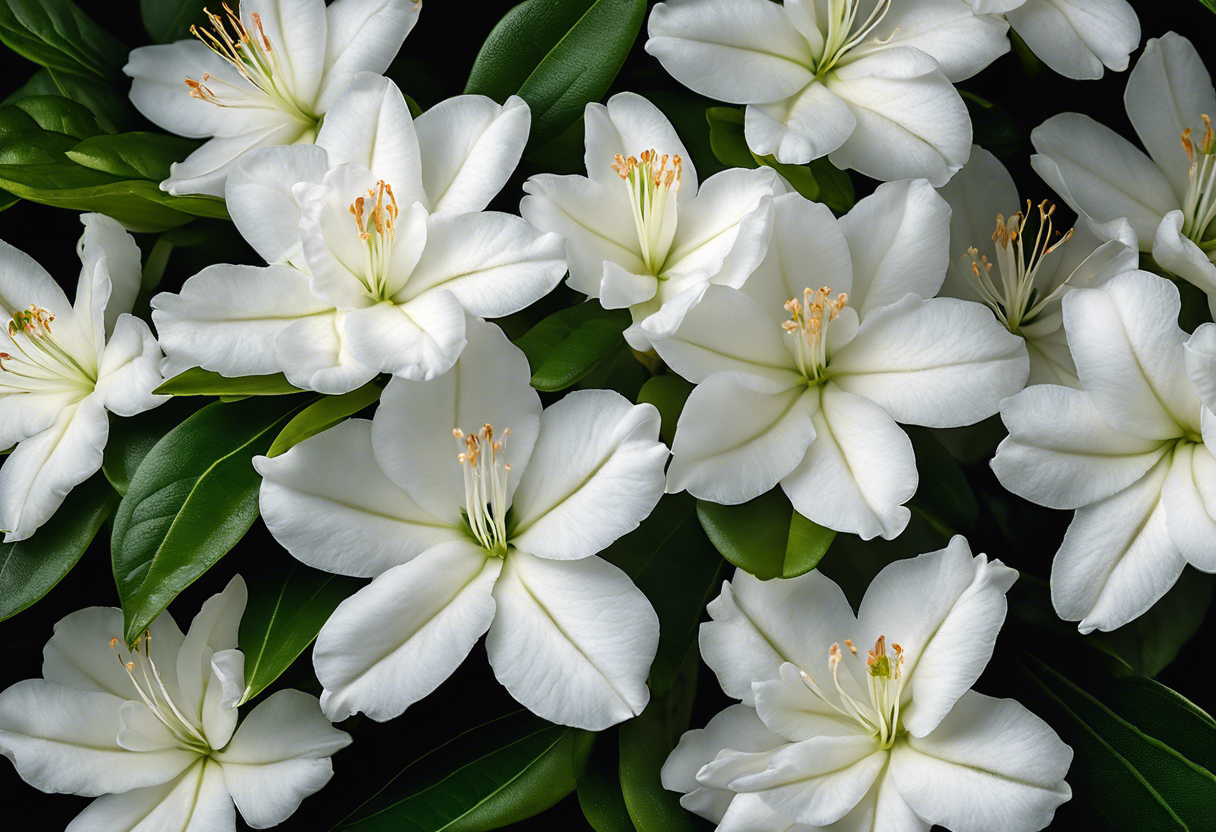Ever stumbled upon a sea of white flowers that seemed to have popped straight out of a fairy tale? Well, chances are you’ve encountered the ethereal beauty of White Azaleas. These blooming wonders are more than just a pretty face, they’re steeped in history and symbolism too.
But hold your horses! Before we dive into the nitty-gritty, let’s take a moment to appreciate their sheer elegance. Just picture it – delicate white petals fluttering in the breeze… Ah, pure bliss! Now, buckle up as we embark on this floral adventure together. Keep reading about ‘All You Need To Know About White Azaleas’.
Key Takeaways
- White Azaleas are popular ornamental shrubs known for their beautiful white flowers.
- They thrive in acidic, well-drained soil and partial shade to full sun exposure.
- Regular watering is essential, but overwatering can lead to root rot.
- Pruning after blooming helps maintain shape and encourages growth.
- Common pests include lace bugs and azalea caterpillars; use of insecticidal soap or horticultural oil can control these.
- Fertilize with a slow-release granular fertilizer specifically designed for acid-loving plants.
What are White Azaleas?
Well, White Azaleas are a sight to behold! They’re a type of Rhododendron species, and boy, do they make for some stunning garden plants. These flowering shrubs, known as Azalea flowers, have been turning heads for centuries.
Origin and History of White Azaleas
Now, let’s take a trip down memory lane. The origin of White Azaleas can be traced back to Asia. Over time, these beauties spread across the globe, becoming a beloved feature in gardens far and wide.
But here’s the fun part – the history of Azalea flowers is steeped in folklore. In ancient times, people believed that these vibrant blooms could communicate with divine entities. Talk about flower power!
The evolution of this particular Rhododendron species has been quite a journey. From their humble beginnings as simple garden plants in the East to their status today as one of the most admired flowering shrubs worldwide – it’s safe to say that White Azaleas have come a long way!
Characteristics of White Azaleas
Alrighty then, let’s talk about what makes these blooming wonders tick. The first thing you’ll notice about White Azaleas is their dazzling white blossoms – they’re like little stars twinkling in your garden!
These plants have unique growth habits too. Unlike some other Rhododendron species, they prefer partial shade and well-drained soil.
Now onto their blooming period – brace yourself because it’s spectacular! When spring rolls around, these azalea flowers put on quite the show with their abundant white blooms.
But remember folks – beauty doesn’t come without effort! To keep your white azalea plants looking fresh and fabulous, they require regular watering and pruning. So roll up your sleeves and show these plants some love!
How to Identify White Azaleas?
Identifying white azaleas can be a delightful task, especially when you’re aware of their unique physical features and the different varieties. So, let’s dive into the world of recognizing white azaleas, shall we?
Physical Features of White Azaleas
First things first, let’s talk about the characteristics of white azaleas. These beauties are known for their spectacular clusters of trumpet-shaped flowers that boast a pristine white hue. But it’s not just about the color. The leaves are also a telltale sign – they’re usually dark green and glossy.
Now, if you’re out there in your garden or maybe taking a stroll in the park, spotting these white azalea features is quite easy once you know what to look for. The bloom time is another giveaway – most white azalea varieties flower in late spring or early summer.
Varieties of White Azaleas
Moving on to the different white azalea varieties, there’s quite a range to choose from. For instance, ‘Delaware Valley White’ is an old favorite with its pure white flowers and hardy nature.
Then there’s ‘Bloom-A-Thon White’, which lives up to its name by blooming twice in a year! Talk about getting more bang for your buck! And let’s not forget ‘Snow’, an aptly named variety known for its snow-white blossoms.
So next time you see those lush clusters of white blooms, remember – you’re not just looking at some random plant. You’re witnessing the diversity in white azalea plants!
Where do White Azaleas Grow Best?
If you’re wondering about the optimal growing conditions for White Azaleas, it’s all about location, location, location! These beauties are quite picky when it comes to their habitat. Let’s dive into the specifics of their ideal climate and soil requirements.
Ideal Climate for White Azaleas
The climate preferences of White Azaleas are pretty specific. They love a moderate temperature range – not too hot, not too cold. Think Goldilocks, but with flowers!
Sunlight is another key factor in the temperature for White Azaleas. They enjoy a good amount of sunlight but don’t want to be sunbathing all day long. A little shade can go a long way.
Humidity levels also play a role in creating the best environment for White Azaleas. They prefer areas with higher humidity levels, so if you live in a dry region, you might need to give them some extra TLC.
Soil Requirements for White Azaleas
When it comes to soil, White Azaleas have some specific needs as well. The soil pH should be on the acidic side – they’re not fans of alkaline conditions.
Drainage is another crucial aspect when considering where to plant White Azaleas. They don’t like waterlogged roots, so ensure your chosen spot has good drainage capacity.
Lastly, these plants crave nutrient-rich soil. So make sure you’re feeding your azalea plenty of organic matter to keep it happy and healthy!
How to Plant and Care for White Azaleas?
Planting Process for White Azaleas
Let’s kick off with the planting white azaleas part. First things first, soil prep is key. Your white azalea planting guide would tell you that these beauties love well-drained, acidic soil. So, get your soil pH tested and amend it if needed.
Next up is spacing. These plants need room to breathe, so space them about 2-3 feet apart. And remember, they love a bit of shade but also need some sun.
Watering and Fertilizing Needs
Moving on to watering and fertilizing needs. Watering white azaleas isn’t rocket science. They like their soil moist but not waterlogged. So, water them regularly but don’t drown ’em!
As for feeding your plants, the best fertilizer for azaleas is one that’s high in nitrogen. Apply it in late spring or early summer when they’re actively growing.
Pruning and Maintenance Tips
Now let’s talk about pruning and maintenance. When it comes to pruning white azaleas, timing is everything! The best time to prune is just after they’ve finished blooming.
And as far as general maintenance goes, keep an eye out for pests and diseases – prevention is better than cure! With these tips in mind, you’ll be well on your way to maintaining healthy azaleas!
Common Problems with Growing White Azaleas
Growing white azaleas can be a rewarding experience, but it’s not without its challenges. From diseases to pests, these lovely plants often face a few hurdles. But don’t worry! With proper white azalea care, you can overcome these common azalea issues and maintain healthy white azaleas.
Diseases Affecting White Azaleas
One of the main problems when growing white azaleas is disease. Some common white azalea diseases include leaf gall and petal blight. Leaf gall causes leaves to swell and deform while petal blight turns flowers brown.
Identifying these diseases early is key to treating diseased white azaleas. Look out for discolored or misshapen leaves and flowers as signs of disease. Once identified, use fungicides or prune affected areas to control the spread.
Prevention is always better than cure, so focus on disease prevention in white azaleas by ensuring good air circulation around your plants and avoiding overhead watering which can create a damp environment that encourages fungal growth.
Pests that Threaten White Azaleas
Pests are another issue when growing white azaleas. Common culprits include lace bugs and spider mites which suck sap from the leaves causing them to turn yellow or silver.
Signs of pest infestation in azaleas include discolored leaves and a sticky residue on the plant or surrounding area caused by insect droppings. If you notice these signs, it’s time to start controlling pests in white azaleas.
There are many ways of dealing with pests in white azaleas including using insecticidal soap sprays or introducing beneficial insects like ladybugs into your garden that prey on harmful pests. Remember, regular monitoring is crucial for early detection and effective pest management.
Benefits and Uses of White Azaleas
When it comes to White Azalea benefits, these lovely blooms are more than just a pretty face. They’re also champions for the environment and a decorator’s dream in landscaping.
Environmental Benefits of Planting White Azalea
Planting White Azaleas is like giving Mother Earth a big ol’ hug. These plants are known for their air-purifying abilities, sucking up pollutants like nobody’s business.
But wait, there’s more! White Azaleas aren’t just about clean air. They’re also great at creating habitats for critters. Birds, bees, and butterflies love them some azalea action.
So, if you’re into sustainable gardening with White Azalea, you’re not only making your garden look good but also doing your part for the environment.
Decorative Uses in Landscaping
Now let’s talk aesthetics. When it comes to landscaping with White Azaleas, these beauties can really make a garden pop!
Their white flowers bring an elegant touch to any landscape design. Plus, they can enhance the overall design by adding depth and contrast.
So whether you’re looking to jazz up your garden or create a serene oasis, White Azaleas got you covered!
To Wrap Up
Well, folks, that’s the skinny on White Azaleas. They’re like the belle of the garden ball – delicate, charming and oh-so-pretty in white!
So don’t just stand there like a wallflower! Get out there, and add some White Azaleas to your green space – they’re sure to be a showstopper!





